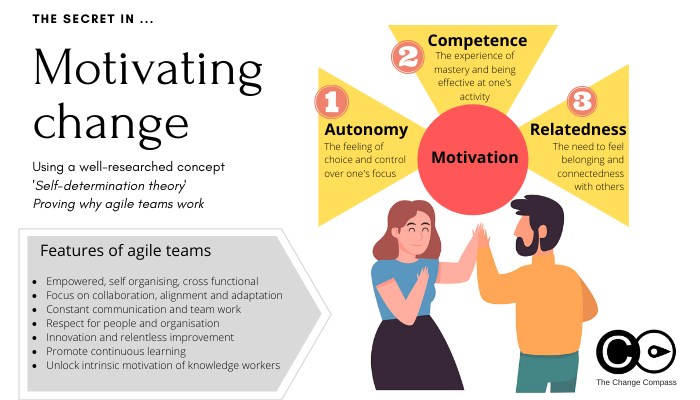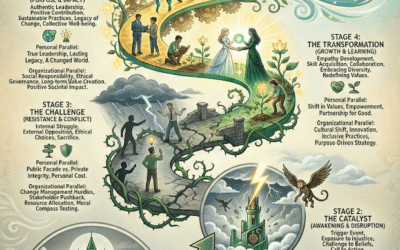Move over older concepts and motivation theories such as Lewin’s, Bridges and Kubler-Ross models that are dated and not based on years of rigorous research….. It’s time we started to focus on well-researched and evidence-backed models that explain people’s behaviours in change. Of course there is no single approach that may provide the best results in the motivation of a group of employees. However, this framework provides valuable insights of the types of motivation for individual employees that lead to employee commitment to organizational change.
Change management practitioners often grapple with the challenge of employee motivation to embrace change. A powerful framework that can guide this process is Self-Determination Theory (SDT), which emphasizes the importance of intrinsic motivation (versus eternal factors) and the fulfilment of basic hierarchy of needs of people within the work environment. This theory of human motivation takes into account critical tiers of human needs of employee development or professional development that leads to the outcome of employee engagement. By understanding and applying SDT, practitioners can create environments that foster genuine motivation for change.
Understanding Self-Determination Theory
SDT identifies three core psychological needs essential for motivation:
- Autonomy: The need to feel in control of one’s actions and decisions as one of the basic needs that leads to employee satisfaction and a positive work environment. When individuals perceive they have a choice, they are more likely to engage willingly in change initiatives.
- Competence: This refers to the desire to feel effective and capable at the individual level that leads to employee performance. Providing opportunities for skill development, career development, performance reviews and positive feedback can enhance individuals’ sense of competence, making them more motivated to pursue change.
- Relatedness: The need to feel connected and understood by others also leads to job satisfaction. Building supportive relationships and social connections foster a sense of belonging, which can significantly enhance motivation. This is a basic condition of human nature that focuses on intrinsic factors rather than external factors of needs theory that lead to job enrichment.
By addressing these needs, change management practitioners can cultivate an environment where individuals are intrinsically motivated to engage in and sustain change.
Applications in Change Management
- Foster Autonomy: Encourage team members to take ownership of their roles in the change process with targeted performance goals. Allow them to set personal goals related to the change initiative and choose how they want to achieve those goals forms a solid foundation. This autonomy can lead to greater commitment and enthusiasm.
- Build Competence: Offer training sessions and resources that help individuals develop the skills necessary for the change. Celebrate small wins to reinforce their capabilities, which boosts confidence and motivation.
- Enhance Relatedness: Create opportunities for collaboration and open communication among team members. Establishing peer support systems or mentorship programs can help individuals feel connected, fostering a supportive environment conducive to change.
Linking SDT with Agile Teams
In Agile environments, where adaptability and collaboration are crucial, SDT aligns perfectly with team dynamics:
- Empowered Teams: Agile practices emphasize self-organizing teams, which inherently supports autonomy. Team members are encouraged to make decisions collectively, enhancing their sense of ownership over the process.
- Continuous Feedback: Agile methodologies promote regular feedback loops, which not only help build competence but also reinforce a culture of learning and growth.
- Collaboration: Agile teams thrive on collaboration, fulfilling the need for relatedness. Daily stand-ups, retrospectives, and pair programming foster connections among team members, enhancing their commitment to shared goals.
Motivating change is not just about implementing new processes; it’s about understanding what drives people. By leveraging Self-Determination Theory, change management practitioners can create an environment that nurtures autonomy, competence, and relatedness. This approach not only facilitates smoother transitions but also cultivates a culture of intrinsic motivation—essential for sustaining long-term change. Embracing these principles within Agile frameworks further enhances team dynamics, making the journey toward change both effective and empowering.
Click here to download the infographic on ‘Self-Determination Theory’ of motivation. Stay tuned for our up-coming article on this.






